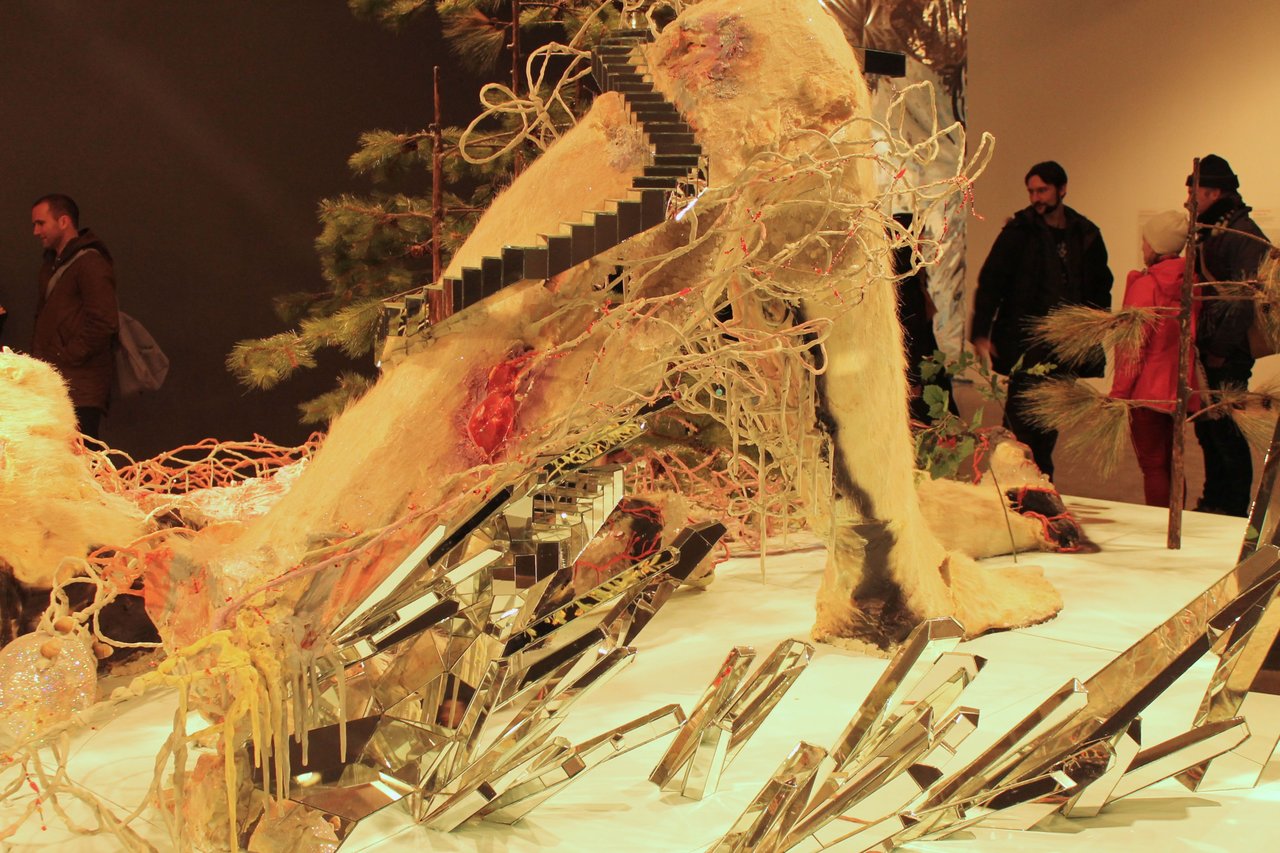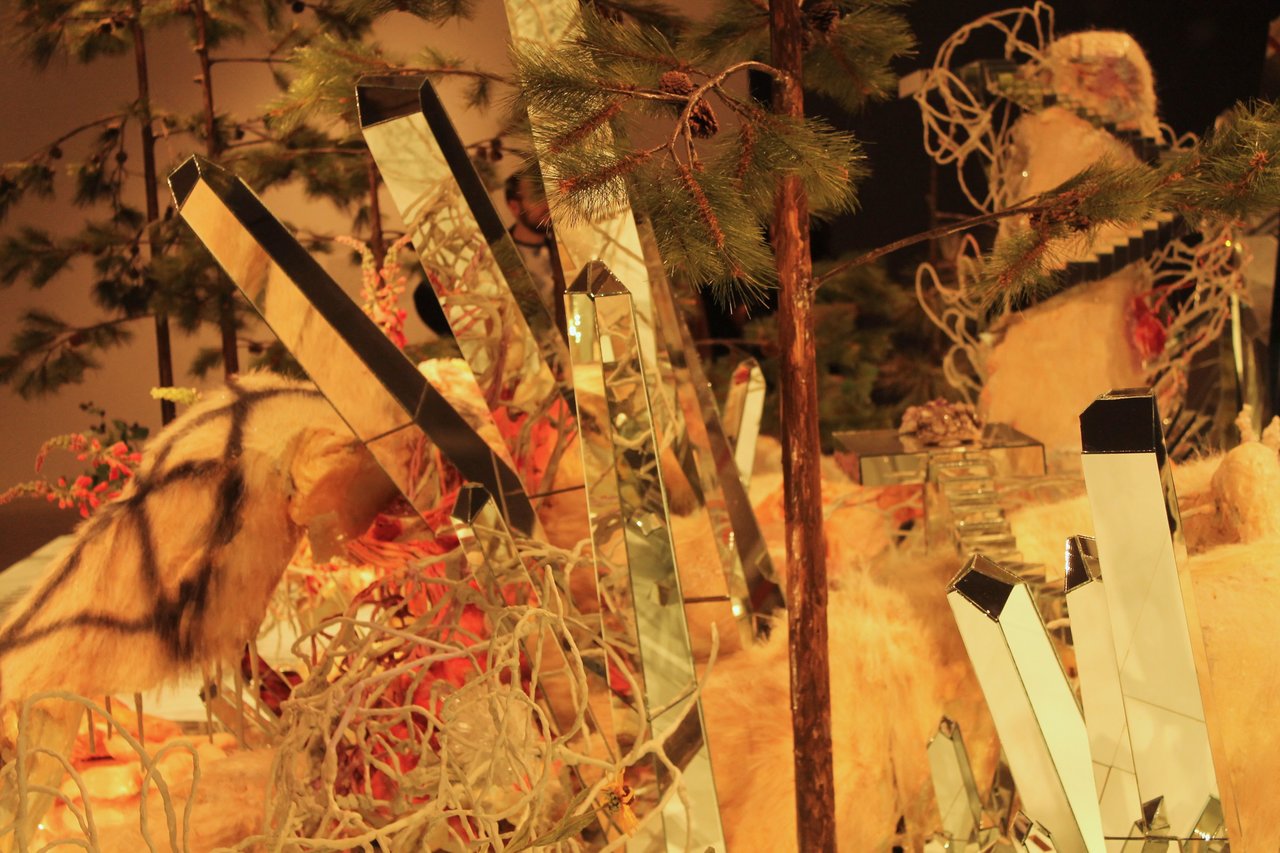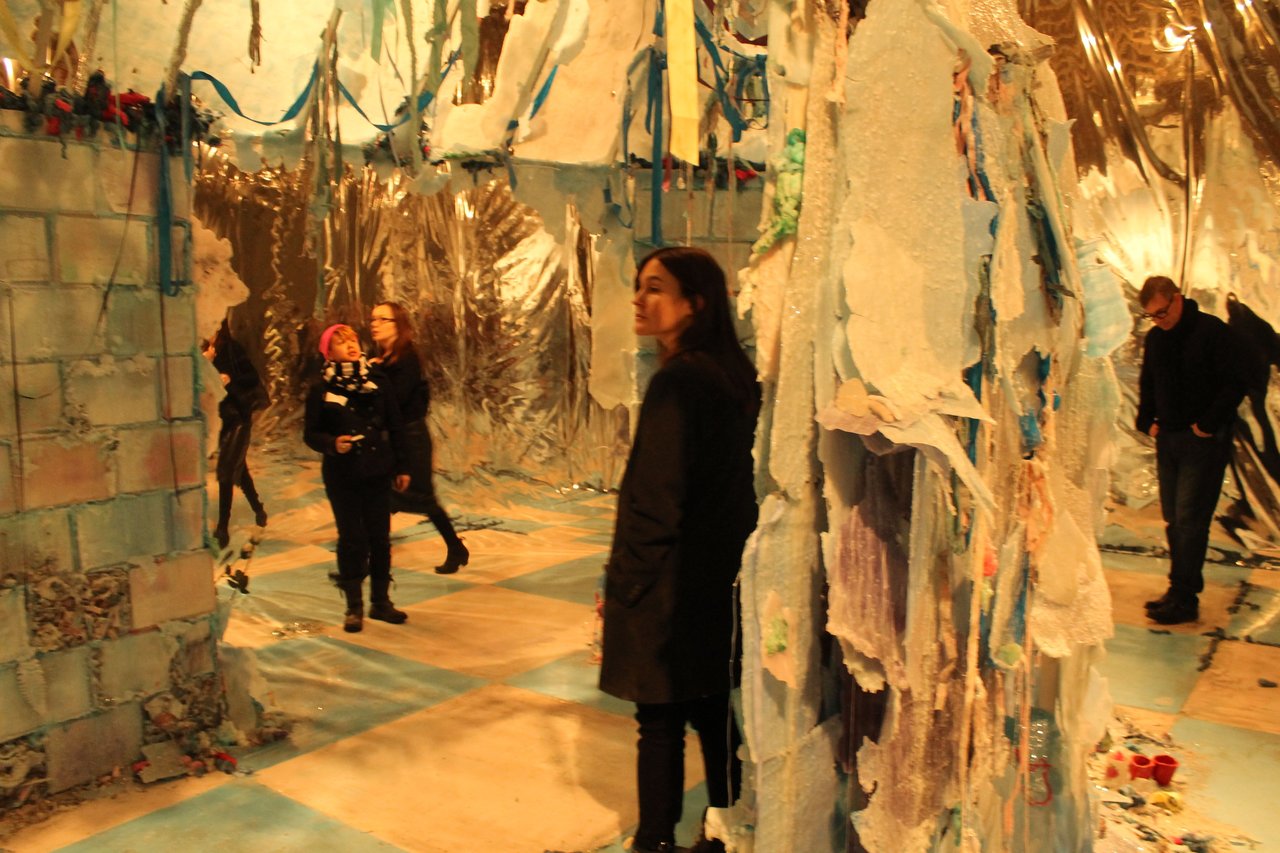Large rotting Wookies, a frosted ice cave and a gorgeous candelabra greet the visitors in Mocca’s warehouse-like interior. These three, rather shocking, monumental installations are very impressive but somewhat challenging.
The intention of the curators was to explore the themes that have come to define the art of the Baroque in the seventeenth century: dramatic, theatrical, and opulent. The title of the exhibition, Misled by Nature, goes back to Johann Joachim Winckelmann (1755). He criticized Gian Lorenzo Bernini’s method of depicting his models in motion in order to capture their unique character as being misguided by nature. The art historian, Michael Snodin (2009) described the Baroque as distortions and extravagancies. Other critics of the era accused the Baroque of stirring the viewers with sensual delights. This exhibition’s goal is to examine how contemporary artists have incorporated these themes into their work. Not an easy task.
 Installation view. Courtesy of Mocca
Installation view. Courtesy of Mocca
New York based Montreal artist David Altmejd’s installation, Holes, 2008, occupies almost the entire room. Two hairy giants (the critic Jerry Saltz called them Wookies), at different stages of decay, recline on a huge plinth’s mirrored surface. Their bodies are torn up; their organs and entrails displayed around them among trees and flowers, making it a a horror movie landscape. Foxtails grow beside kidneys while beautiful crystals reflect bloody intestines. There are thousands and thousands of details to look at, almost too much to stomach. It looks like a morbid diorama from a museum of nightmares. The installation calls for a narrative, a grand récit. It’s easy to connect this to the Baroque theme of Vanitas or Memento Mori, the warning that all will die. In the “double-decker” tombs, to quote Erwin Panofsky’s phrase, a carved stone bier at the top level displays the sculpture of a person as he was before death or soon after, and then as a rotting cadaver at the bottom level, often shrouded and sometimes complete with worms and other flesh-eating wildlife.
 David Altmejd, The Holes, 2008, wood, mirror, glue, plaster, foam, metal wire, epoxy clay, epoxy resin, paint, horse hair, synthetic branches, synthetic flowers, pine cones, glass beads, quartz, quail eggs, glitter, and snail shells, 291.5 x 883.9 x 518.2 cm, detail, National Gallery of Canada.
David Altmejd, The Holes, 2008, wood, mirror, glue, plaster, foam, metal wire, epoxy clay, epoxy resin, paint, horse hair, synthetic branches, synthetic flowers, pine cones, glass beads, quartz, quail eggs, glitter, and snail shells, 291.5 x 883.9 x 518.2 cm, detail, National Gallery of Canada.
 David Altmejd, The Holes, 2008, wood, mirror, glue, plaster, foam, metal wire, epoxy clay, epoxy resin, paint, horse hair, synthetic branches, synthetic flowers, pine cones, glass beads, quartz, quail eggs, glitter, and snail shells, 291.5 x 883.9 x 518.2 cm, detail, National Gallery of Canada.
David Altmejd, The Holes, 2008, wood, mirror, glue, plaster, foam, metal wire, epoxy clay, epoxy resin, paint, horse hair, synthetic branches, synthetic flowers, pine cones, glass beads, quartz, quail eggs, glitter, and snail shells, 291.5 x 883.9 x 518.2 cm, detail, National Gallery of Canada.
Altmejd certainly seems obsessed with the macabre, but on his own terms. “I think about decay not in a negative way, but in the sense of creating a space for things to start growing,” he explains in W magazine, Beyond tomorrow, 2007. Indeed, there are growing things in Holes, trees, flowers, natural vegetation – all fake – while taxidermied squirrels are happily drinking from a crystal pond. Amazing little staircases made of mirrors, climb the legs of the giants and occupy parts of their cadavers, reflecting everything. Still, looking at the whole installation with all those bloody body parts is overwhelming. Any shock or horror a viewer might experience is exactly what Altmejd is going for, that’s why he uses a kind of “context of contrasts,” making the beautiful stand out more juxtaposed against the ugly. But this decay is not simply ugly. It has some strange, cruel beauty as well. Here death is no longer a fearful punishment but a new beginning where all that remains of the body is cherished. The decomposing flesh becomes a symbol for the regeneration of nature and, in some ways, part of the future. The result is something horrifying but also seducing.
 David Altmejd, The Holes, 2008, wood, mirror, glue, plaster, foam, metal wire, epoxy clay, epoxy resin, paint, horse hair, synthetic branches, synthetic flowers, pine cones, glass beads, quartz, quail eggs, glitter, and snail shells, 291.5 x 883.9 x 518.2 cm, detail, National Gallery of Canada.
David Altmejd, The Holes, 2008, wood, mirror, glue, plaster, foam, metal wire, epoxy clay, epoxy resin, paint, horse hair, synthetic branches, synthetic flowers, pine cones, glass beads, quartz, quail eggs, glitter, and snail shells, 291.5 x 883.9 x 518.2 cm, detail, National Gallery of Canada.
Tricia Middleton’s installation, Embracing oblivion and ruin is the only way to live now, 2012, doesn’t have any humans or other creatures in it, so at least we are saved from looking at what happened to them. The title tells us that it is a ruin and Baroque art depicted ruins, but not this kind for sure. At first sight everything looks jolly: the pale blue and pink construction created from pieces of material that could be felt, the building material of Mongol yurt. Inside it seems to be an igloo made of ice blocks. Somehow that doesn’t match, so let’s have a closer look. The whole thing is covered with wax. It looks melted and frozen at the same time. There are roses, little porcelain figurines, mugs and soda cans, all covered with wax. The checkered floor must be the remains of a previous building. The gallery’s walls are covered with metallic sheets that might shelter us from outside dangers like radiation, or is it the other way around? What is this building we are standing in? Is it an igloo or a cave? Is it a place where survivors of the catastrophe find some shelter? I start to have a bad feeling. Soda cans are a 20th Century product, so the last melting and freezing must have happened not very long ago and it could happen again. I can’t help but listen to my gut, suggesting that I get out of here.
 Tricia Middleton, Embracing oblivion and ruin is the only way to live now, 2013 – 14. Mixed media installation.
Tricia Middleton, Embracing oblivion and ruin is the only way to live now, 2013 – 14. Mixed media installation.
In her Artist Talk at the opening of the exhibition, Middleton mentioned among her inspirations the destructive and regenerative cycles of life present in nature such as: decay, bacteria, accretion and decomposition. Her method involve rebuilding and repurposing, as she said, she was “cannibalizing” elements of her installation Dark Souls, 2009 for her current work.
 Tricia Middleton, Embracing oblivion and ruin is the only way to live now, 2013 – 14. Mixed media installation.
Tricia Middleton, Embracing oblivion and ruin is the only way to live now, 2013 – 14. Mixed media installation.
Danger and beauty go hand in hand here. Philosopher Edmund Burke (1757) defined the sublime as the mingling of terror and pleasure inspired, for example, by the sight of storms and ruins. The term fits Middleton’s work perfectly.
Lee Bul’s intricate, mirage-like installation, After Bruno Taut (Negative Capability), 2008, hanging from the ceiling, over a mirrored floor, looks like a luxurious, boat-shaped candelabra at first. It reminds us of Versailles’ Hall of Mirrors, with its many beautiful candeliers, but the comparison to the Baroque ends there. After a closer look, we recognize that the piece is not a chandelier but more like a castle floating in the air. It all goes back to Bul’s 2007 series, Sternbau , inspired by visionary German architect Bruno Taut’s proposals for a crystalline city in the Alps, which date from 1917. In both Taut’s original sketches (The Cathedral Star, 1919) and Bul’s drawings, chandelier-like, dark, hanging shapes sprawl outwards, seemingly out of control. “Human beings are always fated to dream of (utopia) and to plan it,” suggested Bul in her 2007 interview with Grazia Quaroni. “And yet we are also fated to be disappointed by the inevitable realization that it’s unreachable. Still we dream. I am fascinated by those failures, as well as the dreams that the dreamers knew could never materialize.”
![rsz_lee_bul_after_bruno_taut_negative_capability_[2008]](http://www.artoronto.ca/wp-content/uploads/2014/04/rsz_lee_bul_after_bruno_taut_negative_capability_2008.jpg) Lee Bul, After Bruno Taut (Negative Capability), 2008, crystal, glass, and acrylic beads on stainless steel armature with aluminum and copper mesh, with chains made of PVC, steel, and aluminum, 274.3 x 296.4 x 213.4 cm, National Gallery of Canada.
Lee Bul, After Bruno Taut (Negative Capability), 2008, crystal, glass, and acrylic beads on stainless steel armature with aluminum and copper mesh, with chains made of PVC, steel, and aluminum, 274.3 x 296.4 x 213.4 cm, National Gallery of Canada.
This sculptural installation is splendid. It is very large and appears even bigger with multiplied details in the reflections of the mirror covered floor. The visual richness is further enhanced by the sparkling light of the thousands of glass and metal beads that it’s made of. This gorgeous, dazzling star-like construction suggests another kind of world, where shimmering modernist buildings float in the cosmos.
 Lee Bul, After Bruno Taut (Negative Capability), 2008, crystal, glass, and acrylic beads on stainless steel armature with aluminum and copper mesh, with chains made of PVC, steel, and aluminum, 274.3 x 296.4 x 213.4 cm, National Gallery of Canada.
Lee Bul, After Bruno Taut (Negative Capability), 2008, crystal, glass, and acrylic beads on stainless steel armature with aluminum and copper mesh, with chains made of PVC, steel, and aluminum, 274.3 x 296.4 x 213.4 cm, National Gallery of Canada.
Walking around again and having a second look at the installations still doesn’t convince me of their connection to the Baroque. But Baroque or no Baroque, it is an interesting show.
Emese Krunák-Hajagos
Photo: Alice Tallman
*Exhibiton information: Misled by Nature: Contemporary Art and the Baroque. February 8 – April 6, 2014, Museum of Contemporary Canadian Art, 952 Queen Street West. Gallery hours: Tue – Sun: 11 – 6 p.m.
